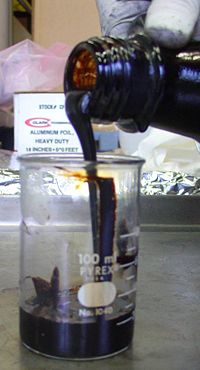Tar
Tar is a viscous black liquid derived from the destructive distillation of organic matter. Most tar is produced from coal as a byproduct of coke production, but it can also be produced from petroleum, peat, or wood.
Types of tar
General
The word "tar" is used to describe several distinct substances. Naturally occurring "tar pits" (such as the La Brea Tar Pits in Los Angeles) actually contain asphalt, not tar, and are more accurately known as asphalt pits. Tar sand deposits contain various mixtures of sand (or rock) with bitumen or heavy crude oil rather than tar, as does the Tar Tunnel in Shropshire.
"Rangoon tar," also known as "Burmese Oil" or "Burmese Naphtha," is actually petroleum. The terms "tar" and "pitch" are sometimes used interchangeably. However, pitch has more of a solid nature, whereas tar is more often a liquid.
Coal tar
In English and French, "tar" is a substance primarily derived from coal. It was formerly one of the products of a gasworks. Tar made from coal or petroleum is considered toxic and carcinogenic because of its high benzene content. However, at low concentrations, coal tar is used as a topical medicine. Coal tar and petroleum tar both have a pungent odor.
Wood tar
In Northern Europe, the word "tar" refers primarily to a substance derived from wood, which is used even as an additive in the flavoring of candy and other foods. Wood tar is microbicidal and has a pleasant odor.
The heating (dry distilling) of pine wood causes tar and pitch to drip away from the wood and leave behind charcoal. Birch bark is used to make particularly fine tar (tökötti). The by-products of wood tar are turpentine and charcoal. When deciduous tree woods are subjected to destructive distillation, the by-products are methanol (wood alcohol) and charcoal.
Uses
Tar is used for treatment of the skin disease psoriasis, for which coal tar is the most effective. Tar is also a general disinfectant. Petroleum tar was also used in ancient Egyptian mummification c. 1000 B.C.E.[1]
Tar was a vital component of the first sealed, or "tarmac," roads. It was also used as sealant for roofing shingles and to seal the hulls of ships and boats. For millennia, wood tar was used to waterproof sails and boats, but today sails made from inherently waterproof synthetic substances have replaced the use of tar. Wood tar is still used to seal traditional wooden boats and the roofs of historical shingle-roofed churches, as well to paint the exterior walls of log buildings.
In Finland, wood tar was once considered a panacea, reputed to heal "even those cut in twain through their midriff." According to a Finnish proverb, "if sauna, vodka, and tar won't help, the disease is fatal." The use of wood tar in traditional Finnish medicine is because of its microbicidal properties.
Wood tar is also available in diluted form as tar water, which has various uses:
- As a flavoring for candies (such as Terva Leijona) and alcohol (Terva Viina)
- As a spice for food, such as meat
- As a scent for saunas—tar water is mixed into water that is turned to steam
- As an anti-dandruff agent in shampoo
- As a component of cosmetics
Mixing tar with linseed oil varnish produces tar paint. Tar paint has a translucent brownish hue and can be used to saturate and tone wood and protect it from weathering. Tar paint can also be toned with various pigments, producing translucent colors and preserving the wood texture. Given its paint-like properties, wet tar should not be touched with bare skin, as it can dry to produce a stain. However, the stain can be effectively removed from skin by applying a paint thinner.
Coal tar is listed at number 1999 in the United Nations list of dangerous goods.
See also
Notes
- ↑ Geo Times, Mummy tar in ancient Egypt. Retrieved April 25, 2008.
ReferencesISBN links support NWE through referral fees
- Newton, David C. 2007. Trademarked: A History of Well-Known Brands, From Aertex to Wright's Coal Tar. Stroud: Sutton. ISBN 978-0750945905
Credits
New World Encyclopedia writers and editors rewrote and completed the Wikipedia article in accordance with New World Encyclopedia standards. This article abides by terms of the Creative Commons CC-by-sa 3.0 License (CC-by-sa), which may be used and disseminated with proper attribution. Credit is due under the terms of this license that can reference both the New World Encyclopedia contributors and the selfless volunteer contributors of the Wikimedia Foundation. To cite this article click here for a list of acceptable citing formats.The history of earlier contributions by wikipedians is accessible to researchers here:
The history of this article since it was imported to New World Encyclopedia:
Note: Some restrictions may apply to use of individual images which are separately licensed.
